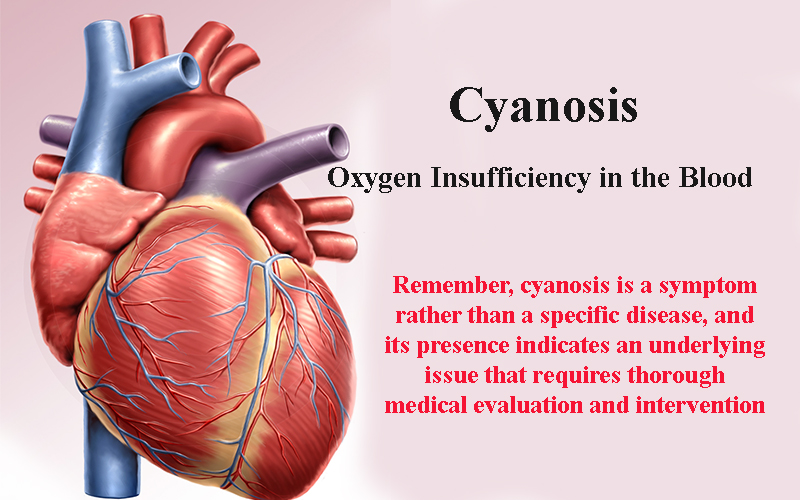Blue Hue: Understanding Cyanosis and Oxygen Insufficiency in the Blood. Cyanosis – Inadequate level of oxygen in the blood.
Medically Cyanosis is an unusual bluish, greyish, or purple colour of the skin and mucous membranes, which is normally found around the lips, fingernails, mouth or palms. This is caused due to inadequate level of oxygen in the blood. Oxygen delivery is measured on the basis of cardiac output and arterial oxygen content. Normally about 98% of oxygen is bound to haemoglobin (approx. – 1.34 mL per 1 g of haemoglobin) and only 2% is dissolved in plasma (approx. 0.003 mL of oxygen per 100 mL of plasma).


Blood is red in colour because of presence of oxygen in the blood. This keeps the skin tone in pink or red tinge. If the blood does not have sufficient oxygen it carries waste carbon dioxide from cells and lungs, which is obviously dark in colour. This makes bluish ting on skin so it must be addressed immediately.
It is seen in new-borns with lung and breathing problems, heart defects (if it allows blood that is not fully oxygenated to pass through arterial circulation) and respiratory distress syndrome. It can also appear at any time later in life when there is insufficient oxygen supply to the blood.
Cyanosis are of two types – Central Cyanosis happens due to heart and lung disorders and unusual forms of haemoglobin (methaemoglobin and sulfhemoglobin in the blood). Peripheral Cyanosis happens due to reduced blood flow to the peripheral parts (fingers, toes and nail beds) of the body.
The typical symptoms of cyanosis are a bluish, greyish, or purplish colour of the lips, fingers, and toes. This is caused when oxygen content in the blood falls below 85%. Standard oxygen level in the blood range between 95% to 100%, which means we may not notice cyanosis until the oxygen level in the blood drips significantly.
Seek medical help immediately if you have chest pain, frequent headaches, fever, breathing difficulty, unable to take a deep breath, cough up dark or blood-tinged mucus. Cyanosis is a serious disease, so if untreated it may lead to major complications and permanent damages like gangrene, ulceration, heart or respiratory failure, loss of limb and sepsis.
Cyanosis is triggered by a wide variety of health issues like – chronic obstructive pulmonary disease (COPD), pulmonary hypertension, pneumonia, respiratory tract infection, asthma, congestive heart failure, Raynaud’s phenomenon, epiglottitis, hypothermia, seizures, suffocation and overdose of drugs.
It is difficult to assess cyanosis because level of haemoglobin varies even for jaundice, anaemia and even with skin colour. However, bluish, greyish, or purplish colour skin is typically a sign of cyanosis. Doctor diagnosis by physical examination and by listening to heart and lungs. Apart from that other clinical tests like arterial blood gas analysis (ABG), blood oxygen saturation by pulse oximetry, duplex doppler or venography, complete blood count (CBC), electrocardiogram or echocardiogram, digital subtraction angiography, chest X-ray, chest computed tomography (CT) scan, ECG and ventilation-perfusion scan or pulmonary angiography tests will help doctors to diagnose cyanosis.
Timely treatment and medications can help to prevent more complications. For cyanosis patient’s oxygen therapy should be given immediately. Further treatments like heat therapy (applying mild heat to the affected areas), antidepressants and antihypertensive medications (for peripheral cyanosis to relax blood vessels), antibiotics or antivirals and surgical treatments depending on the patient’s conditions. Doctors may stop certain medications, if patient is consuming, like decongestants, birth control pills, beta-blockers and migraine medicines because these may add to the complications.
Lifestyle modifications and some preventive steps like avoiding products that has caffeine and nicotine may prove to be helpful. If you are having heart ailments avoid going to high altitudes (like mountain) or take oxygen cylinders while going. Also avoid going to places having extreme temperature. Regular Mild exercise and reduced stress is very beneficial.


Dr Mahantesh R. Charantimath
Senior Consultant Interventional
Cardiologist,
Tathagat Heart Care centre,
32/60, 2nd main Vyalikaval,
Next to Canara bank, Bangalore 03
Ph 080-23462515 Mb: 94484 62883
http://tathagathearthospital.com/











